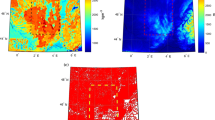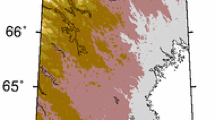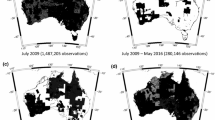Abstract
An inverse Poisson integral technique has been used to determine a gravity field on the geoid which, when continued by analytic free space methods to the topographic surface, agrees with the observed field. The computation is performed in three stages, each stage refining the previous solution using data at progressively increasing resolution (1o×1o, 5′×5′, 5/8′×5/8′) from a decreasing area of integration. Reduction corrections are computed at 5/8′×5/8′ granularity by differencing the geoidal and surface values, smoothed by low-pass filtering and sub-sampled at 5′ intervals. This paper discusses 1o×1o averages of the reduction corrections thus obtained for 172 1o×1o squares in western North America.
The 1o×1o mean reduction corrections are predominantly positive, varying from −3 to +15mgal, with values in excess of 5mgal for 26 squares. Their mean andrms values are +2.4 and 3.6mgal respectively and they correlate well with the mean terrain corrections as predicted byPellinen in 1962. The mean andrms contributions from the three stages of computation are: 1o×1o stage +0.15 and 0.7mgal; 5′×5′ stage +1.0 and 1.6mgal; and 5/8′×5/8′ stage +1.3 and 1.8mgal. These results reflect a tendency for the contributions to become larger and more systematically positive as the wavelengths involved become shorter. The results are discussed in terms of two mechanisms; the first is a tendency for the absolute values of both positive and negative anomalies to become larger when continued downwards and, the second, a non-linear rectification, due to the correlation between gravity anomaly and topographic height, which results in the values continued to a level surface being systematically more positive than those on the topography.
Similar content being viewed by others
References
A. BJERHAMMAR: On the boundary value problem of physical geodesy. Tellus, 21, pp. 451–516, 1969.
R. FORSBERG: A study of terrain reductions, density anomalies and geophysical inversion methods in gravity field modeling. Report #355, Department of Geodetic. Science and Surveying, Ohio State University, 1984.
R. FORSBERG and C.C. TSCHERNING: The use of height data in gravity field approximation by collocation. Jour. Geophys. Res., 86, pp. 7843–7854, 1981.
F.R. GANTMACHER:Applications of the theory of matrices. Interscience Publishers, Inc., New York, 1959.
J.C. HARRISON and M. DICKINSON: Fourier transform methods in local gravity modeling, Bull. Géod., No. 63, pp. 149–166, 1989.
W.A. HEISKANEN and H. MORITZ:Physical Geodesy. Freeman and Co., San Francisco, 1967.
M.S. MOLODENSKII, V.F. EREMEEV and M.I. YURKINA:Methods for the study of the external gravitational field of the earth. Translated from Russian (1960), Israel proram for scientific translations, Jerusalem, 1962.
H. MORITZ: On the use of the terrain correction in solving Molodenskii's problem. Report #108, Department of Geodetic Science, Ohio State University, 1968.
H. MORITZ:Advanced physical geodesy. Herbert Wichman, Karlsruhe, 1980.
R.L. PARKER: The rapid calculation of potential anomalies, Geophys. J.R. Astron. Soc., 31, pp. 447–455, 1972.
L.P. PELLINEN: Accounting for topography in the calculation of quasi-geoidal heights and plumb-line deflections from gravity anomalies. Bull. Géod., No. 63, pp. 57–65, 1962.
R.H. RAPP: The determination of high degree potential coefficient expansion from the combination of satellite and terrestrial gravity information. Report #361, Department of Geodetic Science, Ohio State University, 1984.
M.G. SIDERIS and K.P. SCHWARZ: Advances in the numerical solution of the linear Molodenskii problem. Bull. Géod., 62, pp. 59–69, 1988.
I. STAKGOLD:Boundary value problems of mathematical physics. Volume 1 MacMillan Company, New York, 1969.
R.S. VARGA:Matrix iterative analysis. Prentice-Hall Inc., Englewood Cliffs, NJ, 1962.
Author information
Authors and Affiliations
Rights and permissions
About this article
Cite this article
Martzen, P.D., Harrison, J.C. The reduction correction in North America. Bull. Geodesique 63, 319–330 (1989). https://doi.org/10.1007/BF02519631
Received:
Accepted:
Published:
Issue Date:
DOI: https://doi.org/10.1007/BF02519631




